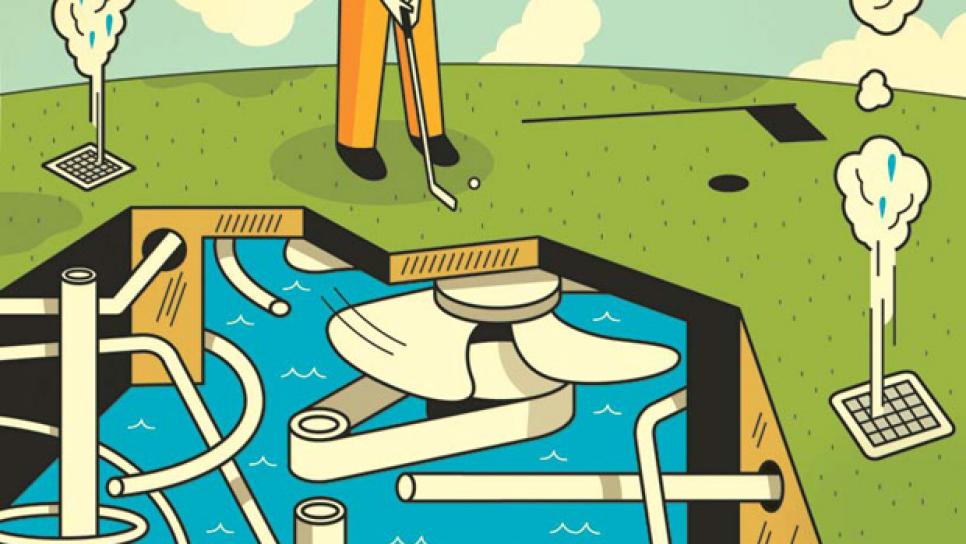News
The SubAir system at Augusta National, explained

If you're watching the Masters at any point—particularly this week with all the cold, wet weather we're seeing in Augusta—you will inevitably hear talk about the SubAir system at Augusta National and how it helps the club regulate the condition of its fairways and greens. What is it exactly?
If you've walked around Augusta National before, you may have noticed that there are metal grates in a number of the greenside mounds. Those grates, and the mechanical hum that periodically emanates from them, are not proof that the tournament is a Matrix-like simulation created by green-jacketed aliens. Instead, the grates provide ventilation for Augusta National's extensive subterranean turf-conditioning system.
I saw an early version of that system at the club in the late-1990s. A heavy rain had fallen during the night, and near one green I noticed a stove-size machine from which a torrent of water was gushing. A member explained that the system was called SubAir and that it had been invented a few years earlier by Marsh Benson, the club's senior director of golf course and grounds. The machine I saw was attached to the existing network of drainage pipes beneath the putting surface and was acting like a giant Shop-Vac, hoovering moisture from below. Since that time, the club has equipped all of its greens with permanent, buried units—hence the grates. And it has extended the system to other parts of the course, including fairway landing areas.
Slurping up downpours is actually not SubAir's primary purpose—as I learned from Kevin Crowe, who is the project director of the company that manufactures the systems. (SubAir's headquarters are in Graniteville, S.C., about 15 miles from Augusta.) Benson's main original idea was to pump air into greens from underneath, and that's what the units chiefly do. "The concept is to supply fresh air into the root zone and help provide a more optimal growing environment for the plants," Crowe explains.
The first Augusta green to receive that treatment was the 12th—a greenkeeping headache since the course was built—and Benson and his staff, after a couple of false starts, noticed rapid improvement in the health of the turf. Removing excess water, by operating in reverse, was secondary.
More than 500 other golf clubs, including Congressional and TPC Sawgrass, now have SubAir systems, in one configuration or another. Northwood Club in Dallas (site of the U.S. Open in 1952) is among them. "When I got here, in 2005, we had one permanent SubAir unit, in the ground, and two portable units," says Kevin Carpenter, the superintendent. The permanent unit was under the 14th green, historically the club's soggiest and most troublesome. That summer the 14th was one of the best greens on the course, Carpenter says. He now budgets for two new permanent SubAir units each year, at an installed cost of $25,000 or $30,000 per green, including the expense of supplying power.
Is SubAir worth it for other non-Augustas? Course architect Tom Doak said that, during the planning for Sebonack Golf Club (which Doak designed with Jack Nicklaus), he offered "to quit the project" if the superintendent insisted on SubAir. Doak believed the system couldn't possibly be necesssary in eastern Long Island, which is about as close as the United States comes to Scottish linksland. Jim Moore, who is the director of construction education and technology for the USGA's Green Section, says, "If you build greens properly, using our method, we don't see a need for SubAir." USGA greens are expensive enough as it is, he says, and their purpose is to provide exactly the kind of gas exchange and drainage that SubAir is meant to promote. Besides, he says, almost any golf course's greens drain better, all by themselves, than its fairways or bunkers.
Not all greens function the way they're supposed to, of course. Last year's summer weather—which was brutal nationwide—left many superintendents looking for technological help. At any rate, if Augusta gets a big rainstorm during the tournament this year, you'll almost certainly see players back in action sooner than you would have if Benson hadn't thought of grooming Augusta's turf from below.
LET'S GO METS
Marsh Benson's invention has found applications outside of golf. Bill Deacon, the director of landscaping and field operations for the New York Mets, turns on his SubAir system each year in late February, four or five weeks before opening day. He also uses it to clean up after rainstorms and to ventilate the field when it's covered for concerts. He doesn't run it during games, however. "It's loud," he says, "and the louvers are right by the bullpens.
(This article originally appeared in a 2011 issue of Golf Digest.)
MORE GOLF DIGEST MASTERS PREVIEW STORIES:
Masters 101: Frequently Asked Questions
Every player in the field at the 2023 Masters, ranked
‘It’s not my life’: Scottie Scheffler on focus, patience and his keys to being patience
A casual fan’s guide to the 2023 Masters
The most memorable rules controversies in Masters history
50 defining moments in Masters history, ranked
Augusta’s expansion debate—a second course, more housing and even more influence
15 people who ended up in Augusta’s penalty box
Inside the big-money world of Augusta rentals during Masters week